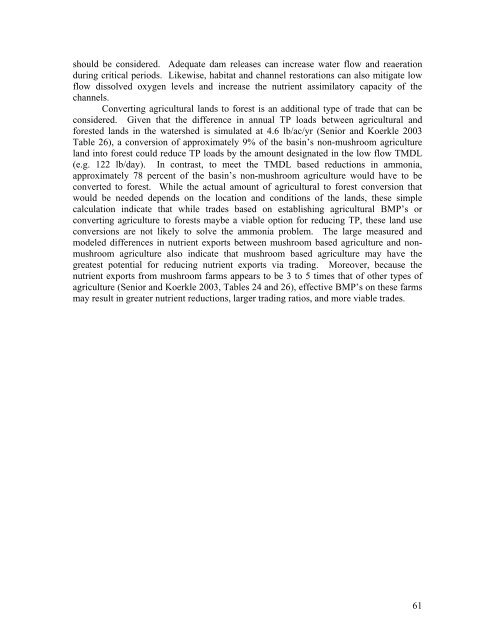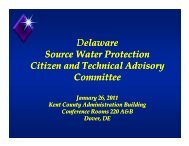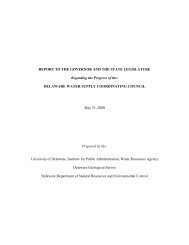Water Quality Trading in the Lower Delaware River Basin: A ...
Water Quality Trading in the Lower Delaware River Basin: A ...
Water Quality Trading in the Lower Delaware River Basin: A ...
Create successful ePaper yourself
Turn your PDF publications into a flip-book with our unique Google optimized e-Paper software.
should be considered. Adequate dam releases can <strong>in</strong>crease water flow and reaeration<br />
dur<strong>in</strong>g critical periods. Likewise, habitat and channel restorations can also mitigate low<br />
flow dissolved oxygen levels and <strong>in</strong>crease <strong>the</strong> nutrient assimilatory capacity of <strong>the</strong><br />
channels.<br />
Convert<strong>in</strong>g agricultural lands to forest is an additional type of trade that can be<br />
considered. Given that <strong>the</strong> difference <strong>in</strong> annual TP loads between agricultural and<br />
forested lands <strong>in</strong> <strong>the</strong> watershed is simulated at 4.6 lb/ac/yr (Senior and Koerkle 2003<br />
Table 26), a conversion of approximately 9% of <strong>the</strong> bas<strong>in</strong>’s non-mushroom agriculture<br />
land <strong>in</strong>to forest could reduce TP loads by <strong>the</strong> amount designated <strong>in</strong> <strong>the</strong> low flow TMDL<br />
(e.g. 122 lb/day). In contrast, to meet <strong>the</strong> TMDL based reductions <strong>in</strong> ammonia,<br />
approximately 78 percent of <strong>the</strong> bas<strong>in</strong>’s non-mushroom agriculture would have to be<br />
converted to forest. While <strong>the</strong> actual amount of agricultural to forest conversion that<br />
would be needed depends on <strong>the</strong> location and conditions of <strong>the</strong> lands, <strong>the</strong>se simple<br />
calculation <strong>in</strong>dicate that while trades based on establish<strong>in</strong>g agricultural BMP’s or<br />
convert<strong>in</strong>g agriculture to forests maybe a viable option for reduc<strong>in</strong>g TP, <strong>the</strong>se land use<br />
conversions are not likely to solve <strong>the</strong> ammonia problem. The large measured and<br />
modeled differences <strong>in</strong> nutrient exports between mushroom based agriculture and nonmushroom<br />
agriculture also <strong>in</strong>dicate that mushroom based agriculture may have <strong>the</strong><br />
greatest potential for reduc<strong>in</strong>g nutrient exports via trad<strong>in</strong>g. Moreover, because <strong>the</strong><br />
nutrient exports from mushroom farms appears to be 3 to 5 times that of o<strong>the</strong>r types of<br />
agriculture (Senior and Koerkle 2003, Tables 24 and 26), effective BMP’s on <strong>the</strong>se farms<br />
may result <strong>in</strong> greater nutrient reductions, larger trad<strong>in</strong>g ratios, and more viable trades.<br />
61




